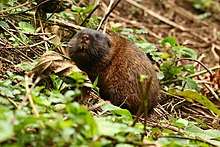Rodent farming
Rodent farming is an agricultural process in which rodents are bred and raised with the intent of selling them for their meat. They are often categorised in a sub-category of livestock known as micro-livestock, due to their small size. Rodents have been used as food in a wide range of cultures, including Hawaiian, Vietnamese, French, Indian and Thai.

Rodent farming has been suggested as a solution to the world's increased requirements for food associated with an increasing population as a result of a number of perceived benefits with their production and consumption.
As food
Rodents have been hunted and farmed in a number of cultures. The polynesian rat was hunted and consumed by the common people in pre-contact Hawaii.[1] Capybaras, agoutis, and guinea pigs have historically been eaten in South America -- guinea pigs were farmed as far back in 2500 BCE in what is now Peru.[2] Cane rats can grow up to 60 cm in length and weigh up to 10 kg and are hunted as bush meat in western and central Africa.[2] Rats were commonly eaten during the Tang Dynasty in China; they may have been domesticated as they were called “household deer”.[2] The Mishmi people in the Lohit district in India traditionally hunted rats.[3] Dishes with rats captured in wine cellars are described in Larousse Gastronomique and rats are eaten in rural Thailand.[4]
Farming
In the contemporary era, rodent farming has been suggested as a sustainable agriculture method to address current global malnutrition and to meet the needs of the world's growing population.[2][5] Rodent farming can be economically efficient, since they can produce a large number of offspring per year, have a limited gestation period, and have a high feed conversion ratio.[2] They require little space, so could be farmed in urban areas.[2]
Efforts have been made to develop rat farming among the dalit in the Indian state of Bihar; one obstacle to this is that the animal vehicle of the god Ganesh is a rat.[6]
In Cameroon, cane rats is encouraged in economic development efforts.[2][7]
In Australia, a rat farm that provides food for zoos and pet stores was the subject of a 2018 profile.[8]
Management
Rodents can be kept in sheds or cages, and fed grain, pellets, or scraps.[2][8] In nations with strict animal cruelty regulations, such as Australia, the animals must be killed humanely, for example by gassing with carbon dioxide.[8] In nations without these regulations, it is more common for the animals to be killed by drowning or bludgeoning.[9]
See also
- Cuniculture, farming rabbits (a lagomorph)
References
- Kirch, Patrick; O'Day, Sharyn Jones (2003-01-01). "New archaeological insights into food and status: a case study from pre-contact Hawaii". World Archaeology. 34 (3): 484–497. doi:10.1080/0043824021000026468. ISSN 0043-8243.
- Gruber, Karl (2016-05-01). "Rodent meat – a sustainable way to feed the world?". EMBO Reports. 17 (5): 630–633. doi:10.15252/embr.201642306. PMC 5341521. PMID 27113761.
- Mills, J. P. (1952). "The Mishmis of the Lohit Valley, Assam". The Journal of the Royal Anthropological Institute of Great Britain and Ireland. 82 (1): 1–12. doi:10.2307/2844036. JSTOR 2844036.
- Schwabe, Calvin W. (1979). Unmentionable Cuisine. University of Virginia Press. ISBN 9780813911625.
- "Part IV: Rodents". Microlivestock: Little-Known Small Animals with a Promising Economic Future. The National Academies Press. 1991. ISBN 978-0-309-04295-6.

- "Rat Farming- An opportunity for food security | Vijoy Prakash". vijoyprakash.in. Retrieved 2018-09-06.
- Gruber, Karl (7 December 2015). "The countries where rats are on the menu". BBC.
- Moffat, Nicky. "Is this the weirdest kind of farm on the Sunshine Coast?". Sunshine Coast Daily. Retrieved 2018-09-06.
- "India's 'outcasts' turn to rat farming". The National. Retrieved 6 October 2018.